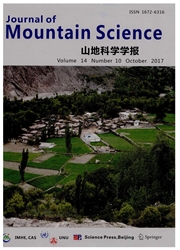

 中文摘要:
中文摘要:
一张详细山崩危险性地图用逻辑回归方法在 Youfang 集水被生产,数据集为一个地理信息系统(GIS ) 发展了。在中国, Longnan 山区域的 Youfang 集水,它在 Qinghai 西藏高原之中躺在过渡区域,黄土高原和四川盆作为最山崩容易的区域之一知道,作为一个代表性的盒子被选择评估山崩的频率和分发。为山崩危险性评价的统计关系用山崩和山崩被形成原因的因素数据库。逻辑回归(LR ) 被用来基于一系列可得到的数据来源创造山崩危险性地图:山崩库存;距离到排水系统,差错和道路;斜坡角度和方面;地志的举起和地形学的湿索引,和陆地使用。在这份报纸生产的山崩危险性地图的质量被验证,结果能被用于设计保护并且对山崩危险的缓解措施。山崩危险性地图被期望在 Youfang 集水为山崩危险评价和风险管理提供一个基本工具。
 英文摘要:
英文摘要:
A detailed landslide susceptibility map was produced in the Youfang catchment using logistic regression method with datasets developed for a geographic information system(GIS).Known as one of the most landslide-prone areas in China, the Youfang catchment of Longnan mountain region,which lies in the transitional area among QinghaiTibet Plateau, loess Plateau and Sichuan Basin, was selected as a representative case to evaluate the frequency and distribution of landslides.Statistical relationships for landslide susceptibility assessment were developed using landslide and landslide causative factor databases.Logistic regression(LR)was used to create the landslide susceptibility maps based on a series of available data sources: landslide inventory; distance to drainage systems, faults and roads; slope angle and aspect; topographic elevation and topographical wetness index, and land use.The quality of the landslide susceptibility map produced in this paper was validated and the result can be used fordesigning protective and mitigation measures against landslide hazards.The landslide susceptibility map is expected to provide a fundamental tool for landslide hazards assessment and risk management in the Youfang catchment.
 同期刊论文项目
同期刊论文项目
 同项目期刊论文
同项目期刊论文
 GIS-based logistic regression for landslide susceptibility mapping of the Zhongxian segment in the T
GIS-based logistic regression for landslide susceptibility mapping of the Zhongxian segment in the T GIS-Based and Data-Driven Bivariate Landslide-Susceptibility Mapping in the Three Gorges Area, China
GIS-Based and Data-Driven Bivariate Landslide-Susceptibility Mapping in the Three Gorges Area, China GIS-based rare events logistic regression for landslide-susceptibility mapping of Lianyungang, China
GIS-based rare events logistic regression for landslide-susceptibility mapping of Lianyungang, China Investigating Spatial Patterns of Persistent Scatterer Interferometry Point Targets and Landslide Oc
Investigating Spatial Patterns of Persistent Scatterer Interferometry Point Targets and Landslide Oc Quantitative hazard and risk assessment for slow-moving landslides from Persistent Scatterer Interfe
Quantitative hazard and risk assessment for slow-moving landslides from Persistent Scatterer Interfe 期刊信息
期刊信息
